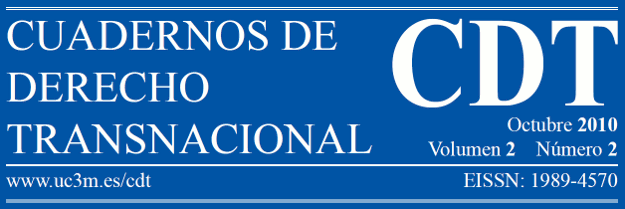Cuadernos de Derecho Transnacional, Issue 1/2011
The first issue for 2011 of the Cuadernos de Derecho Transnacional, the Spanish journal published twice a year by the Área de Derecho Internacional Privado of Univ. Carlos III of Madrid under the editorship of Alfonso Luis Calvo-Caravaca (Univ. Carlos III) and Javier Carrascosa-González (Univ. of Murcia), has been recently published. It contains twenty articles, shorter articles and casenotes, encompassing a wide range of topics in conflict of laws, conflict of jurisdictions and uniform law, all freely available for download from the journal’s website.
Here’s the table of contents (each contribution is accompanied by an abstract in English):
Estudios
- Dário Moura Vicente, Principios sobre conflictos de leyes en materia de Propiedad Intelectual;
- Hilda Aguilar Grieder, El impacto del Reglamento «Roma I» en el contrato internacional de agencia;
- Celia Caamiña Domínguez, El secuestro internacional de menores: soluciones entre España y Marruecos;
- Celia Caamiña Domínguez, La «supresión» del exequátur en el R 2201/2003;
- Sergio Cámara Lapuente, El concepto legal de «consumidor» en el Derecho privado europeo y en el Derecho español: aspectos controvertidos o no resueltos;
- Maria Ersilia Corrao, Il diritto internazionale privato e processuale europeo in materia di obbligazioni alimentari;
- Pietro Franzina, La garanzia dell’ osservanza delle norme sulla competenza giurisdizionale nella proposta di revisione del Regolamento «Bruxelles I»;
- Miguel Gómez Jene, Inmunidad y transacciones mercantiles internacionales;
- Aurora Hernández Rodríguez, El contrato de transporte aéreo de pasajeros: algunas consideraciones sobre competencia judicial internacional y Derecho aplicable;
- Mónica Herranz Ballesteros, Prohibiciones y limitaciones del artículo 4 de la Ley 54/2007: entre los objetivos de la norma y la realidad en su aplicación;
- Stefan Leible, La importancia de la autonomía conflictual para el futuro del Derecho de los contratos internacionales;
- Clelia Pesce, Sottrazione internazionale di minori nell’Unione Europea: il coordinamento tra il Regolamento (CE) n. 2201/2003 e la Convenzione dell’Aja del 1980.
Varia
- Alfonso-Luis Calvo Caravaca, Javier Carrascosa González, Notas críticas en torno a la Instrucción de la Dirección General de los Registros y del Notariado de 5 octubre 2010 sobre régimen registral de la filiación de los nacidos mediante gestación por sustitución;
- María Pilar Canedo Arrillaga, Notas breves sobre la sentencia del TJUE (Sala Cuarta) de 25 febrero 2010 (Car Trim: asunto C-381/08): los contratos de compraventa y los contratos de prestación de servicios en el Reglamento 44/2001;
- Federico F. Garau Sobrino, La literalidad interpretada desde la coherencia del sistema. Las relaciones entre el Reglamento Bruselas I y los convenios sobre materias particulares según el TJUE;
- Federico F. Garau Sobrino, Notas sobre la colisión de fuentes de Derecho internacional privado español sobre responsabilidad parental y protección del niño;
- Natividad Goñi Urriza, La concreción del lugar donde se ha producido el hecho dañoso en el art. 5.3 del Reglamento 44/2001: nota a la STJCE de 16 de julio de 2009;
- Carlos Andrés Hécker Padilla, Denial of justice to foreign investors;
- Aurora Hernández Rodríguez, El Derecho aplicable al contrato en ausencia de elección por las partes: el asunto Intercontainer Interfrigo y su repercusión en el Reglamento Roma I;
- Julia Suderow, Nota sobre la sentencia del TJCE Akzo Nobel y otros de 14 de septiembre de 2010: límites al privilegio legal de las comunicaciones entre abogados y sus clientes.
See also our previous posts on past issues of the CDT (1/2009, 2/2009 and 2/2010). The journal’s website provides a very useful search function, by which contents can be browsed by issue of publication, author, title, keywords, abstract and fulltext.
(Many thanks to Federico Garau, Conflictus Legum blog, for the tip-off)



 The papers presented at the
The papers presented at the